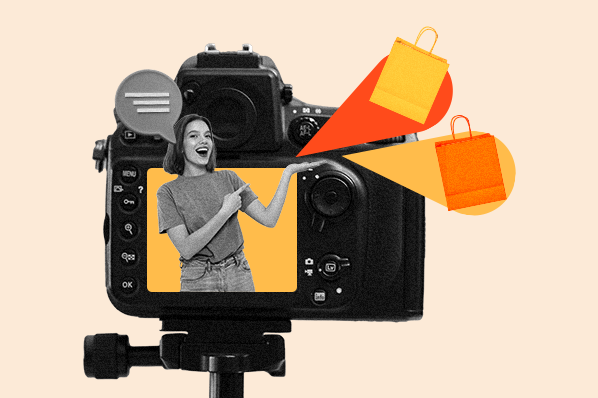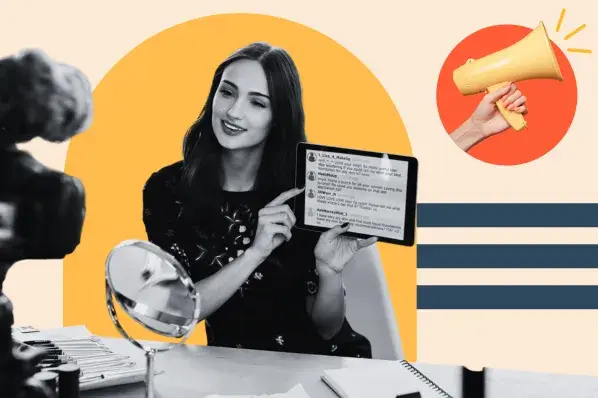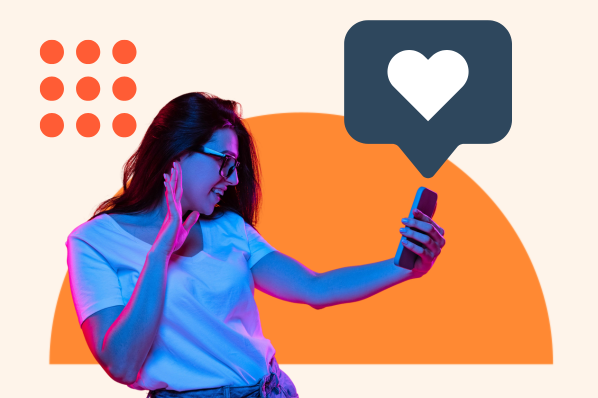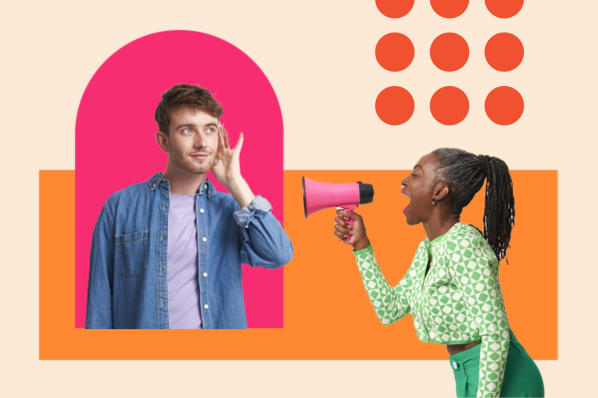Once relegated to print publications, sponsored content is thriving in the online marketing space. We’ll explain what sponsored content is, give best practices, and provide tips for staying within federal advertising guidelines.
Skip to:
- Sponsored Content Definition
- Sponsored Content Examples
- FTC Guidelines
- Sponsored Content Best Practices
This type of content is most engaging when you sponsor a company or influencer who targets your core audience and already discusses topics that align with your brand. When this is done right, any mention of your brand feels like a natural fit rather than an invasive advertisement.
Instead of thinking they just saw an advertisement, audiences should come away from sponsored content feeling like they’ve learned something interesting. This makes your brand look more credible, memorable, and — most importantly — trustworthy.
When it comes to branded or sponsored content, trust is a major factor that engages potential customers. In fact, when marketers sponsor content from a trusted publisher, they see a 50% higher brand lift than marketers who make their own content.
As branded and sponsored content gains steam, research continues to show that marketing your product with quality content can be incredibly effective. In fact, content marketing gets three times more leads than paid search advertising.
How to Distinguish Sponsored Content
Although sponsored content is engaging and effective, it still occasionally gets confused with more traditional native ads.
Native advertising is when a brand creates editorial content that centers around their product. Then, they might pay a website or publisher to share it in a way that naturally flows within a list of content on their homepage.
Here’s an example of a native ad that appeared on Huffington Post’s homepage. Aside from the advertisement attribution under the headline, the post about senior entitlements is designed to show up on the page just like a regular news story.
 When you click it expecting a regular post, you’re sent to a branded article that purely highlights services and discounts from Money Nation.
When you click it expecting a regular post, you’re sent to a branded article that purely highlights services and discounts from Money Nation.
.webp?width=600&height=402&name=Full%20page%20native%20advertisement%20offering%20senior%20discounts%20(1).webp)
While you might want to consider a native ad that goes directly to a product page for immediate sales or traffic purposes, leading readers down a conversion path too soon could turn off audiences.
Since people may scroll past or tune out when they see content that’s obviously created by an advertiser, a piece of sponsored content created by a trusted source might be a stronger alternative.
Once you’re ready to start sponsoring content, it can still be difficult to come up with a list of content ideas or identify brands that you could sponsor. To help inspire you, here are a few great examples.
Sponsored Content Examples
Sponsored Photo or Video Content
Most consumers want to see videos from brands, so it’s no surprise that video and photo content are gaining attention from sponsors. Here are three great examples of video and photo posts:
Good 'n' Fun
Dog treat brand Good 'n' Fun used some real dog fans to get the word out about its chews and provide some social proof. The photo shows two happy pups excitedly staring a 3 bags of the brand's treats.
The cute pups belong to digital creator Dulce Randall who created the sponsored post for the brand. The sponsored post fit perfectly in with her content which follows her cute Husky and Corgi on different adventures.
Michelob Ultra
Michelob sponsored a Tastemade recipe video which used the beer as an ingredient in a shrimp ceviche tostada dish. The video shows how the beer is used as a flavoring ingredient and lists its name in the video caption.
In this example, Michelob was able to sponsor relevant content and get a natural product plug without altering Tastemade’s video recipe style.
Another great thing about this content is that it doesn’t just cater to beer drinkers or Michelob-specific fans. Someone who doesn’t drink beer regularly, but wants to cook this recipe as shown, might still have a reason to purchase Michelob Ultra.
In the small business world, a local restaurant might sponsor a recipe video like this created by a food blogger to show off a meal they cook at their restaurant. You might also see a food or ingredient vendor similar sponsor a recipe video where their ingredients are listed.
Seedip
This Instagram post from Imbibe, a blog that informs users of interesting alcoholic beverages, shows off photos of Seedip, a non-alcoholic spirit.
The caption directs audiences to the account’s bio where they can find the link to a recipe that includes Seedip as an ingredient. It also describes the drink and uses hashtags like #sponsored to signal that the content was paid for.
This is another example of how sponsoring content from a brand that aligns well with yours can create a more natural feeling campaign.
This type of sponsored style might be helpful to other companies in the food and beverage industry. For example, if a local wine brewery sponsored a restaurant’s social post which highlighted a new line of wines, this could help the wine brand gain awareness and potential purchases from the restaurant’s followers.
Sponsored Podcasts
Podcasting is growing. In fact, in 2018, we discovered that 17% of marketers planned to add podcasting to their strategy.
While big brands like GE and Microsoft have already created their own shows, other marketers have focused on sponsoring podcasts that relate to their field or have a similar target audience. Sponsoring a podcast allows marketers to gain awareness from listeners without having to put time and effort into creating their own content from scratch.
Here are two examples:
Rise and Grind
This 10-episode podcast series was sponsored by ZipRecruiter and hosted by Shark Tank’s Daymon John. The series ran in correlation with the launch of John’s book, also titled Rise and Grind.
The content aligned well with both John and ZipRecruiter as it included interviews from entrepreneurs and business leaders, career and interview tips, and motivational advice. ZipRecruiter is occasionally mentioned, but the content is mainly editorial in nature.
Here’s one of the podcast’s mini-episodes, titled “Motivational Minute: Take the Shot.”
For companies in B2B or highly-professional fields, sponsoring a podcast that features executive-level tips and advice allows your audience to see how in touch your brand is with its industry.
A sponsored podcast might also inform new audiences with similar interests about your brand when they tune in to hear an interview.
My Brother, My Brother and Me
The My Brother, My Brother and Me podcast, also known as MBMBaM, is a comedic show that touches on news and pop culture. When they have a sponsor, they come up with a topic that relates to the advertiser or use product placement strategies.
One of the most notable and extreme examples was when they hosted a “Family Fun Hour” sponsored by Totinos. During the episode, they gave a brief history of Totino’s, discussed their favorite snacks from the company, and played games that included Totino’s foods. This was considered as a brand new strategy at the time and was noted on sites like Vulture.
While this is an unusual example where product placement takes up most of the show, it demonstrates how content creators can develop something unique and still centered around a product.
Sponsored Influencer Content
Currently, 80% of marketers report that influencer marketing is an effective strategy. While many marketers have taken part in co-marketing with influencers, some have also sponsored their content.
One of the platforms where influencer marketing thrives most is Instagram. Here are a few examples of how brands are sponsoring influencer content on the platform:
NordicTrack Sponsors Ben Gravy
In this humorous clip, semi pro surfer & vlogger Ben Gravy documents how using a NordicTrack stationary bike has helped him recover from a surfing injury.
The video follows Gravvy as he hilariously goes through his new workout routine on the bike when he can't ride the waves. The bike helps him continue to focus on building leg strength and cardio as he recovers. The Instagram reel is funny, relatable, and shows the product in action.
OTOTO Sponsors Hungry Artist NY
Kitchen product company OTOTO made a tasty collaboration with influencer foodie Hungry Artist NY. Since Justin (AKA Hungry Artist) is known for his drool-inducing food content, OTOTO was able to work it's products seamlessly into a recipe for garlic scallion noodles with steak.
In this case the featured product was a pair of OTOTO's tongs used to flip the garlic bread and handle the hot cookie sheet to keep Justin from burning himself. It wasn't forced and utilized a simple callout that didn't interrupt the flow of the video.
CR7 Footwear Sponsors Cristiano Rinaldo
In this post, Cristiano Rinaldo, a soccer star and the most-followed person on Instagram, shares a picture of himself relaxing in CR7 Footwear.
Cristiano is no stranger to sponsored posts and he has mastered the art of natural product plugs. Because the photo shows him lounging and reading a book, rather than just his shoes, fans might feel like they're seeing a behind-the-scenes photo of him, rather than a promotion.
Since Cristiano is a major athlete and influencer who's recommended apparel in the past, viewers of this post might trust and follow his shoe endorsements, even if the footwear isn't athletic.
While the sponsorship of an athlete seems ideal for companies that sell sporting goods or clothing, this placement shows how a major influencer can successfully promote a number of products that aren't just limited to their industry.
Coach Sponsors Selena Gomez
Here’s an example where Coach sponsored an Instagram post from Selena Gomez, the former most-followed person on Instagram. In the post’s caption, she shares details about a Coach outfit she’s wearing.
This is a good example of sponsor and promoter alignment. Coach is a high-fashion company and Selena Gomez regularly shares her outfits and thoughts about fashion on her social platforms. To viewers, this might feel like her usual posts where she casually shares what she’s wearing.
On a smaller scale, this sponsored content strategy could be helpful for ecommerce stores or boutiques who want to promote their products by paying someone with a large following to take photos with them.
Lulus Sponsors Lexi Mars
Influencer Lexi Mars has published a few sponsored Instagram posts for Lulus. In these posts, she puts on a few of their outfits and shows off other accessories from the brand.
Like other influencers on this list, she tags Lulus in her posts. This enables her fans to visit their account, learn more about their brand, and potentially follow them.
In the video post below, she tries on dresses from Lulus and captions the video as "outfit ideas for graduation."
Like the Selena Gomez example, this sponsorship aligns well with both the clothing company and the influencer's brands.
Lexi regularly posts pictures of her outfits and videos with fashion tips, so this video will not seem unusual or forced to her fans. The style of clothing is also similar to the outfits she wears in other pictures, so fans who remember her usual fashion choices might not be disrupted by the ad.
Because Lexi also highlights that these are graduation outfits, she might engage members of her following who are graduating, as people searching Instagram for graduation dress inspiration.
This type of influencer strategy might be helpful to boutiques, physical stores, or ecommerce shops that want to promote their seasonal or event-related clothing.
Tractor Supply Sponsors A Dog Named Stella
In this sponsored post from @ADogNamedStella, Stella’s owner films her exploring s Tractor Supply store with her family. In the video, the dog and children play with toys and items on the shelves and there are ample shots taken around the store. The video also shows friendly staff playing with the dog.
Although there are some detailed shots of the store, this video is still focused on telling the dog’s story, which makes the content a bit more interesting than a generic marketing video.
By sponsoring the content of a popular dog influencer, who has over 284,000 followers, Tractor Supply might be spreading awareness about its products to dog owners and dog lovers that might not know they sell items other than landscaping supplies.
Unlike many sponsored pieces, which often highlight online services on products, this content also creatively shows off a physical business. Sponsored content like this could be an effective way to show off products in a small or local shop that doesn’t offer an online store just yet.
Sponsored Articles
Sponsored articles have been around for years. While they were common in print publications, they have easily made the jump to blogs and online news sites.
According to a study by Neilsen and Mode Media, consumers spend 2.5 minutes reading a sponsored article. That’s roughly the same amount of time that they spend reading a standard editorial piece.
Here’s one example of sponsored article content from Huffington Post.
Sleep Number
In a piece sponsored by the Sleep Number mattress company, Huffington Post readers are offered a quiz and a slideshow on the science of sleep.

Unlike the native ad from Huffington Post that was shown above, this piece has the same design as all the other editorial posts on the website. It also has editorial newspegs and credibly sourced information including a fact from the CDC.
In the meat of the post, there is only one mention of Sleep Number. They also include sponsorship language at the end rather than in the middle or at the beginning. This makes the post feel more editorial and less like an ad.
This example seems like it would be of value to audiences who want to learn more about the science of sleep.
The quiz and scientific facts also make it feel more engaging and credible. A user who reads this or takes the quiz might think that Sleep Number is a go-to mattress company because they’ve been affiliated with editorial content about sleep.
Sponsoring editorial content like this could be a good strategy for businesses with an audience base that has interests in reading news or blogs online.
For example, a gym might sponsor a piece on fitness tips for the elderly in the health section of their local newspaper. With a piece like that, audiences who visit the newspaper site or pick up the physical paper might learn more about why staying fit is important and decide to join the gym.
FTC Sponsored Content
Even though sponsored content might be more valuable to a customer than a traditional ad, it's still legally considered a form of advertising and is subject to specific guidelines. You’ll still need to follow the Federal Trade Commission’s online advertising and marketing guidelines.
On social media platforms, acknowledging that content is sponsored can get tricky. In 2017, the FTC sent more than 90 letters and published an online announcement reminding influencers and brands to clearly state when they have a “material connection” to a brand.
This means that a company or influencer must disclose when another company has given them a payment or another resource in return for publishing an endorsement or sponsored content
To avoid any regulatory issues, many influencers and brands now use a hashtag such as #ad or #sponsored on social platforms if there is no other way to clearly disclose a sponsorship in a post. Hashtagging seems to be a go-to on Instagram, which currently has over 2.5 million posts marked with “#sponsored.”
While you should take time to read up on all the FTC requirements that could impact your campaigns, here are the biggest guidelines to keep in mind when posting or publishing sponsored content:
- Make sure the content is free of any misleading claims or lies. For example, a supplement company shouldn’t say their vitamins cure a disease when they have not proven to do so.
- Even if you are posting on social media, clearly disclose when content is sponsored and who the sponsor is. With this disclosure, audiences will know that some aspects of the content were paid for.
- If your content is on your website or your sponsor’s, make sure the font of the disclosure is legible. The text and color should be easy to see and ideally different from the body copy’s style. A note that content is an advertisement, sponsored, promoted or presented by a company should appear in the post itself as well as near the headline if a CTA for it is featured on a homepage.
Disclaimer: We're not lawyers, and the above shouldn't be taken as legal advice. Consult a legal professional.
Tips for Creating Sponsored Content
When working with a sponsor to create interesting and compelling content, here are a few tips to keep in mind:
- Aim to sponsor content that attracts and delights your audience. If it’s enjoyable, they’ll continue to consume it and potentially click on your links.
- When looking for the content creator, choose a company, influencer, or publisher with a similar audience or mission. If people see an endorsement or sponsored post from an entity they trust, they’ll be more aware of a product and more likely to buy it. This will also make any plugs or product mentions feel less like an ad.
- Work with the sponsor to pick a topic that aligns with your goals and your audience’s interests. For example, if you’re a makeup company, sponsoring an influencer’s tutorial that highlights your products might be beneficial.
- Focus on creating engaging content first and product plugs second. If you’re content feels like it’s solely advertising a product, people might tune out.
- Sponsor content that goes beyond blog formatting. Be sure to consider videos, photos, and podcasts. These three areas are gaining more and more interest from marketers and consumers alike.
Conclusion
Sponsored content can allow you to reach new audiences and gain valuable trust from prospective customers. But, unlike native ads, you don’t have to sacrifice your team’s bandwidth to create it.
As you start looking for someone to sponsor, keep an eye out for people or brands that align with your mission and feel like a natural fit.
If you’re excited by the idea of branded content, but aren't interested in working with a sponsor, check out these engaging examples of native advertising.
Editor's note: This article was originally published in July 2019 and has been updated for comprehensiveness. 
Influencer Marketing




.webp?width=400&height=692&name=Hungry%20Artist%20NY%20(1).webp)
.jpg)



![Influencer Marketing Strategy: How to Build a Plan Creators & Customers Will Love [+ Templates]](https://53.fs1.hubspotusercontent-na1.net/hubfs/53/influencer-marketing-strategies-featured.png)

-1.png)
.webp)

